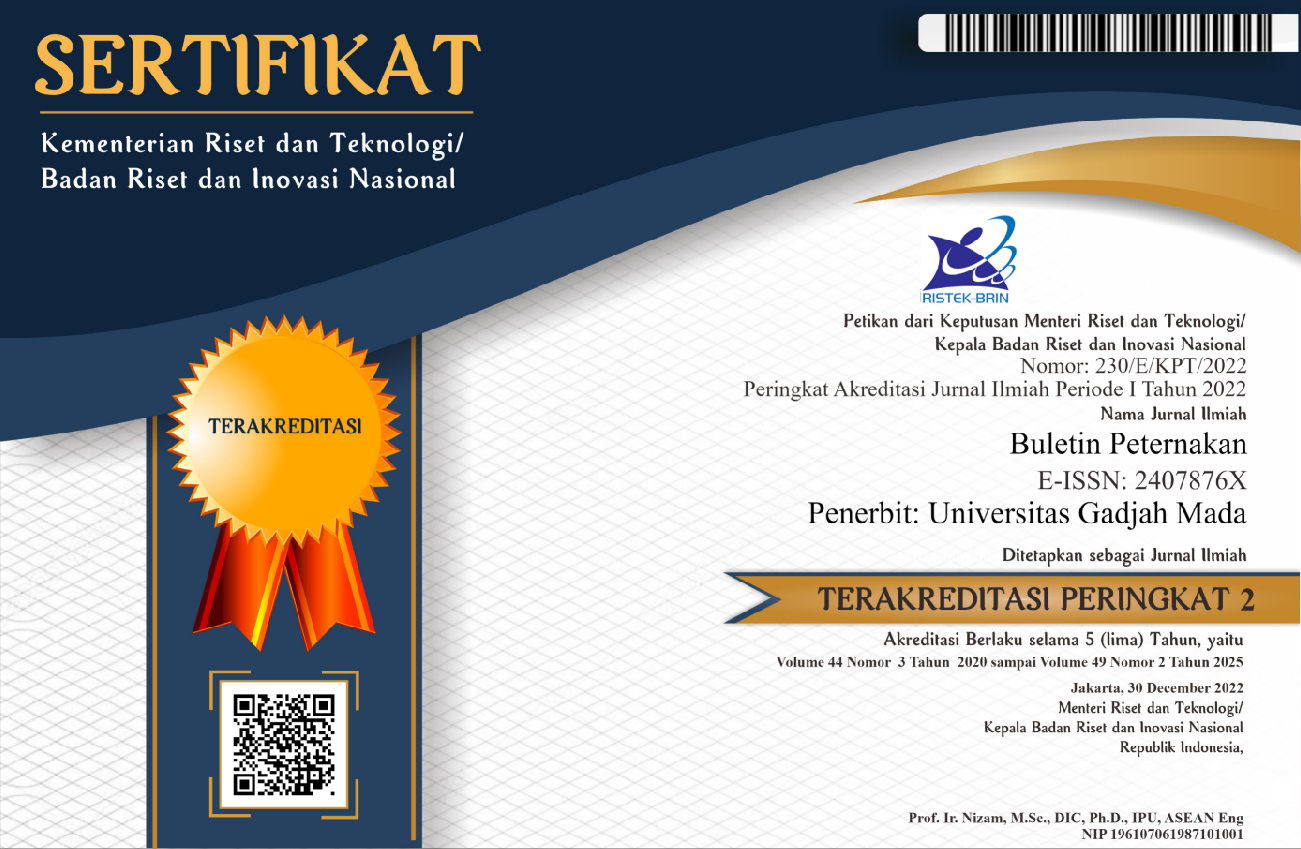Evaluation of Chamois Leather Using Corn Oil (Zea Mays) as The Tanning Material
wehandaka - pancapalaga(1*), Suyatno Suyatno(2), Hysam Jamaluddin(3)
(1) university of muhammadiyah Malang
(2) university of muhammadiyah Malang
(3) university of muhammadiyah Malang
(*) Corresponding Author
Abstract
One of the main characteristics of chamois leather is its high ability to absorb water; thus, chamois leather is generally used for cleaning and drying. The usual tanning material for chamois leather is fish oil. However, it makes the chamois leather product have a strong odor. This study aims to evaluate the quality of chamois leather from rabbit skin tanned with corn oil. The treatments included the addition of several corn oil concentrations consisting of P0 (30 % fish oil), P1 (10 % corn oil), P2 (20% corn oil), and P3 (30% corn oil). The results showed that corn oil as a tanning material was able to increase the ash content, elongation, tear strength, and water absorption of chamois skin and was able to reduce oil content, and did not change the tensile strength, color and odor of the chamois leather produced. The quality of chamois leather with 30% corn oil indicated the ash content as much as 3.19%, oil content as much as 7.87%, elongation as much as 94.51%, tear strength as much as 46.47 N/mm, water absorption (24 hours) as much as 279.03%; and tensile strength as much as 9.9 N/mm2. It also produced yellowish-white color with no odor. This quality has met the requirements of the Indonesian National Standard (SNI): 0617521990. The study concludes that 30% corn oil can substitute fish oil to produce chamois leather.
Keywords
Full Text:
PDFReferences
Abdullah, A. H. D., S. Chalimah, I. Primadona, and M. H. G. Hanantyo. 2018. Physical and chemical properties of corn, cassava, and potato starch. IOP Conf. Series: Earth and Environmental Science. doi :10.1088/1755-1315/160/1/012003.
Aldilah, R. 2017. Strategi pengembangan agribisnis jagung di Indonesia. Analisis Kebijakan Pertanian 15: 43-66. DOI: http://dx.doi.org/10.21082/akp.v15n1
BSN (Badan Standardisasi Nasional). 1989a. Standard Nasional Indonesia SNI 0563: 1989: Metode Uji Kadar Abu pada Kulit. BSN, Jakarta.
BSN (Badan Standardisasi Nasional). 1989b. Standard Nasional Indonesia SNI 0564: 1989: Metode Uji Kadar Minyak pada Kulit. BSN, Jakarta.
BSN (Badan Standardisasi Nasional). 1990a. Standard Nasional Indonesia SNI 06-1795-1990: Metode Uji Kemuluran, Kekuatan Tarik dan Kekuatan Sobek pada Kulit. BSN, Jakarta.
BSN (Badan Standardisasi Nasional). 1990b. Standar Nasional Kulit Samoa (chamois) SNI 06-1752-1990. Badan Standarisasi Nasional, Jakarta.
Ketaren, S. 2008. Introduction to Technology of Food, Oil and Fat. UI-Press, Jakarta.
Krishnan, S. H., V. J. Sundar, N. Vedaraman, V. H. Babu, C. Muralidharan, and S. Sadulla. 2005a. Studies on chamois tanning – an investigation using modified fish oil. J. American Leather Chemists Association. 100: 61-65.
Krishnan, S. H., V. J. Sundar, T. Rangasamy, C. Muralidharan, and S. Sadullla. 2005b. Studies on chamois leather – tanning using plant oil. J. Society Leather Technologists Chemists. 89: 260-262.
Lawal, A. S. and C. P. Odums. 2015. Tanning of different animal skins/hides and study of their properties for textile application. British J. Appl. Sci. Tech. 5: 588-594.
Maharani, A. T., Y. S. Darmanto, and P. H. Riyadi. 2015. The effect of fatliquoring with material and oil concentration on quality of tanned Tilapia (Oreochromis niloticus) skin. Jurnal Pengolahan dan Bioteknologi Hasil Perikanan 4: 1- 6.
Mustakim, A., S. Widiati, and D. S. Ardianto. 2006. Pengaruh presentase penggunaan kuning telur ayam ras dalam proses peminyakan terhadap kekuatan sobek lidah, keretakan rajah dan kadar lemak cakar ayam pedaging samak kombinasi (khrom nabati). Jurnal Ilmu dan Teknologi Hasil Ternak 2: 14-27.
Novia, D. 2009. Pengaruh perlakuan awal daun/ranting tanaman gambir (Uncaria Gambir Roxb) terhadap kadar tannin ekstrak yang dlhasilkan dan kemampuan penyamakannya pada kulit kambing. Jurnal Peternakan 6: 22-28.
O'kuru, R. H., A. M. Abdellatif, J. Xu, and B. K. Sharma. 2011. Synthesis and characterization of corn oil polyhydroxy fatty acids designed as additive agent for many applications. J. American Oil Chemists' Society. 88: 1211-1221.
Pahlawan, I. F. and E. Kasmudjiastuti. 2012. Pengaruh jumlah minyak terhadap sifat fisis kulit ikan nila (Oreochromis niloticus) untuk bagian atas sepatu. Majalah Kulit, Karet dan Plastik 28: 105-111.
Peris, N., Wainaina, P. Tanui, and B. Ongarora. 2019. Extraction of oil from tannery fleshings for chamois leather tanning. J. Society Leather Technologists Chemists. 103: 159-162.
Rahmat, A., L. Sahubawa, and I. Yusuf. 2008. Pengaruh pengulangan pengapuran dengan kapur tohor (CaO) terhadap kualitas fisik kulit ikan pari tersamak. Majalah Kulit, Karet dan plasttik 24: 19-24.
Sandhya, K. V., N. Vedaraman, V., John sundar, R. Mohan, K. C. Velappana, and C. Muralidharan. 2015. Suitability of different oils for chamois leather manufacture. J. American Leather Chemists Association. 110: 221-226.
Suparno, O. 2010. Optimization of chamois leather tanning using rubber seed oil. J. American Leather Chemists Association. 105: 189-194.
Suparno, O. and I. Febianti. 2014. Penentuan waktu oksidasi untuk proses penyamakan kulit samoa dengan minyak biji karet dan oksidator natrium hipoklorit. Prosiding Seminar Nasional Kulit, Karet dan Plastik 3: 107-121.
Steel, R. G. D and J. H .Torrie. 1991 Principles and Procedures of Statistics 2nd Edn. International Book Compan, Tokyo.
Vedaraman, N., R. Muralidharan, V. J. Sundar, K. C. Velappan, and C. Muralidharan. 2014. Modified jatropha oil for making chamois leather. Bio Technology an Indian Journal. 9: 203-205.
Vedaraman, N., K. V. Sandhya, V. J. Sundar, K. C. Velappan, and C. Muralidharan. 2012. Studies on use of fish oil methyl ester for Chamois leather manufactur. J. American Leather Chemists Association. 107: 423-428.
Article Metrics
Refbacks
- There are currently no refbacks.

This work is licensed under a Creative Commons Attribution-ShareAlike 4.0 International License.
Buletin Peternakan (Bulletin of Animal Science) Indexed by:

This work is licensed under a Creative Commons Attribution-ShareAlike 4.0 International License.









